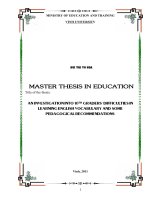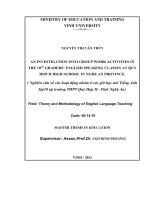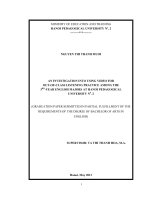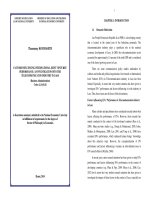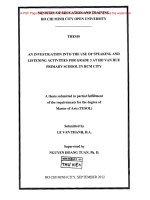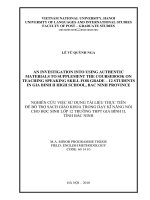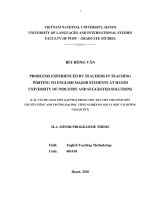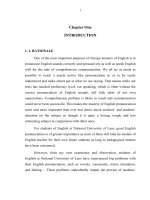AN INVESTIGATION INTO USING AMERICAN MOVIES IN MOTIVATING 11TH FORM ENGLISH GIFTED STUDENTS AT LAM SON GIFTED h
Bạn đang xem bản rút gọn của tài liệu. Xem và tải ngay bản đầy đủ của tài liệu tại đây (313.88 KB, 50 trang )
ABSTRACT
The importance of American culture is undeniable in English language.
Therefore, investigating new ways to motivate students to learn American culture is
apparently necessary to gain effective English teaching and learning and using
American movies in the process is not exception.
This minor thesis was carried out with an investigation into using American
movies in motivating 11th form English gifted students at Lam Son Gifted High
School - Thanh Hoa province to understand American culture.
The minor thesis is organized in 3 parts:
Part A: presents the rationale, aims and significance of the study, research
questions, scope, method and design of the study. Part B: consists of 4
chapters
The first chapter concentrates on the background of the study and the related
literature reviews, on which the contents of the study are based.
The second chapter focuses on developing the research methodology, in
which the two questionnaires for 11th form English gifted students and teachers of
English at Lam Son Gifted High School are chosen as main instruments.
The third chapter is to present the data collected from the two questionnaires
and to analyze the data.
The fourth chapter aims at discussing the findings on how to use American
movies in English class as the best solutions in the hope to motivate 11 th form
English gifted students to understand American culture.
Part C: summaries the study and offers some suggestions for further study.
i
LIST OF ABBREVIATIONS
LSGHS: Lam Son Gifted High School.
AE: Advanced English
BA: Basic English.
ESL: English as a Second Language
EFL: English as a foreign language
ii
LIST OF TABLES
Figure 1: Students’ awareness of having an understanding of American
Culture.................................................................................................................................................... 20
Figure 2: Students’ awareness of the importance of American culture.........................21
Figure 3: Students’ awareness of learning American culture........................................... 21
Figure 4: How interesting?............................................................................................................ 22
Figure 5: How difficult ?................................................................................................................ 22
Figure 6: Students’ opinions on finding out more about American culture................23
Figure 7: Students’ opinions about the methods of using American movies..............23
Figure 8: Students’ opinions about using American movies in English class............24
Figure 9: Students’ participation in American movies........................................................ 25
Figure 10: Students’ feeling on American movies................................................................ 25
iii
TABLE OF CONTENTS
Page
ABSTRACT............................................................................................................................................ i
LIST OF ABBREVIATIONS........................................................................................................ ii
LIST OF TABLES............................................................................................................................ iii
TABLE OF CONTENTS............................................................................................................... iv
PART A: INTRODUCTION......................................................................................................... 1
1. Rationale............................................................................................................................................. 2
2. Aims of the study............................................................................................................................. 2
3. Scope of the study............................................................................................................................ 2
4. Methodology...................................................................................................................................... 2
5. Structure of the study..................................................................................................................... 3
PART B: DEVELOPMENT.......................................................................................................... 4
CHAPTER 1: LITERATURE REVIEW................................................................................ 4
1.1. Culture and American culture.................................................................................................. 4
1.2. The role of the culture in language teaching and learning?......................................... 5
1.3. The role of movies in teaching and learning culture……………………………6
1.4. Previous studies on the use of movies in English teaching process..........................7
1.5. The use of cultural artifacts in teaching culture: Movies as cultural artifacts.....8
1.6. What is motivation?.................................................................................................................... 9
1.7. Relationships between teaching culture and students' motivation.......................... 10
1.8. Criteria to choose movies....................................................................................................... 11
CHAPTER 2: THE STUDY........................................................................................................ 13
2.1. The setting of the study........................................................................................................... 13
2.1.1. English teaching and learning situation at Lam Son Gifted High School........13
2.1.2. English teaching staff........................................................................................................... 13
2.1.3. English gifted students......................................................................................................... 13
iv
2.1.4. The 11th form English gifted students........................................................................... 13
2.2. Research methodology............................................................................................................. 14
2.2.1. Research questions................................................................................................................ 14
2.2.2. Research design...................................................................................................................... 14
2.2.3. Participants............................................................................................................................... 14
2.2.3.1. The subjects.......................................................................................................................... 14
2.2.3.2. The participants................................................................................................................... 15
2.3. Data collection instrument...................................................................................................... 15
2.3.1. Questionnaire........................................................................................................................... 15
2.3.1.1. Questionnaire for the students....................................................................................... 15
2.3.1.2. Questionnaire for the teachers....................................................................................... 16
2.3.2. Classroom observations....................................................................................................... 16
2.4. Data collection procedures..................................................................................................... 16
2.5. Data analysis................................................................................................................................ 17
CHAPTER 3: FINDINGS............................................................................................................ 18
3.1. Results............................................................................................................................................ 18
3.1.1. The 11th form English gifted students' motivation to understand American
culture..................................................................................................................................................... 18
3.1.1.1. Students’ awareness of learning American culture................................................ 18
3.1.1.2. Students’ awareness of the necessity and importance of American culture19
3.1.2. Students’ perception of the use of American movies in English
lessons..................................................................................................................................................... 20
3.1.3. Challenges................................................................................................................................. 23
3.2. Conclusion of the chapter 3................................................................................................... 25
CHAPTER 4: IMPLICATIONS ON USING AMERICAN MOVIES IN
MOTIVATING 11TH ENGLISH GIFTED STUDENTS AT LAM SON
GIFTED HIGH SCHOOL TO UNDERSTAND AMERICAN CULTURE .........27
4.1. Providing students with a full awareness of the importance of American culture
27
v
4.2. Improving students’ background knowledge of American culture and Crosscultural Communication................................................................................................................... 28
4.3. How to use American movies in English lessons.......................................................... 30
4.4. How to motivate 11th English gifted students to understand American culture
through American movies............................................................................................................... 32
4.5. Conclusion of the chapter 4................................................................................................... 33
PART C: CONCLUSION............................................................................................................. 35
3.1. Conclusion.................................................................................................................................... 35
3.2. Limitations of the study........................................................................................................... 36
3.3. Suggestions for further study................................................................................................ 36
REFERENCES.................................................................................................................................. 37
APPENDICES...................................................................................................................................... I
vi
PART A: INTRODUCTION
1. Rationale
Foreign language learning is comprised of several components, including
grammatical competence, communicative competence, language proficiency, as
well as a change in attitudes towards one’s own or another culture. For scholars and
laymen alike, cultural competence, i.e., the knowledge of the conventions, customs,
beliefs, and systems of meaning of another country, is indisputably an integral part
of foreign language learning, and many teachers have seen it as their goal to
incorporate the teaching of culture into the foreign language curriculum.
In Vietnam, in recent years, English as a foreign language has gained
considerable attention. It has become a compulsory subject in the syllabus of many
schools, colleges and universities. However, the fact is that the combination of
culture and English teaching-learning process has not been effective yet, especially
that in gifted high schools like Lam Son Gifted High School- Thanh Hoa province.
There are still many English gifted students who have low motivation in learning
English and cannot understand English-American culture.
As a teacher of English at Lam Son Gifted High School, the researcher is
concerned about the teaching methods to promote her students' motivation in
learning English and understanding American culture. She also realizes that movie
is the product of a series of modern technology, containing elements of art,
language and culture, so movies can be viewed as a useful tool for teaching and
learning culture. Language and culture are two factors that cannot be separated. In
order to learn a foreign language, we have to learn the culture along with perceiving
the language. Among English – speaking countries, American culture is more
abundant than other cultures in England, Canada….. Thus, the researcher decided
to introduce American culture to 11th form English gifted students through the
American movies presented in English class at Lam Son Gifted High School. Also,
1
among different teaching methods, using American movies into the lessons is
considered a method that is worth trying and investigating.
2. Aims of the study
The purpose of the study is to investigate the effectiveness of using
American movies in lessons to promote 11th form English gifted students at Lam
Son Gifted High School - Thanh Hoa province to learn and understand American
culture.
3. Scope of the study
Although there are many different ways to motivate students to learn English
and to understand American culture, they cannot be fully covered in the scope of a
thesis. Due to the word limit and the time frame of the study, the researcher only
focused on investigating the use of American movies as a way of motivating 11th
form English gifted students to understand American culture at Lam Son Gifted
High School. Besides, the target subjects that the study investigated were 40
students from 02 classes of grade 11 at this school.
4. Methodology
This study was intended to be conducted as an action research study. In this
action research, the researcher used some different methods based on study
quantitative and qualitative approaches: a survey questionnaire for students, a
survey questionnaire for teachers of English and classroom observations.
5. Structure of the thesis
The thesis is divided into three parts: the introduction, the development, and
the conclusion
Part A: Introduction – presents the basic information including rationale, aims,
significance, research methods, scope, and the structure of the thesis. Part B:
Development – consists of three chapters.
Chapter 1: Literature Review – provides the literature concerning motivation
in second language learning, culture and the role of the culture in language teaching
and learning, the relationship between teaching culture and students’ motivation
2
Chapter 2: The study – reports the setting, the research hypothesis,
participants, instruments, data collection procedure and analysis. The detailed
results of the surveys and a critical comprehensive analysis on the data collected are
also presented in this chapter.
Chapter 3: Findings – shows major findings and discussions and offers
recommendations for motivating students to understand American culture through
using American movies in English lessons.
Chapter 4: Implications on using American movies in motivating 11th
English gifted students at Lam Son gifted high school to understand American
culture.
Part C: Conclusion – is a summary of the study in which conclusions of the study
are presented. Limitations of the study and suggestions for further research are also
presented in this part.
3
PART B: DEVELOPMENT
CHAPTER 1: LITERATURE REVIEW
1.1. Culture and American culture
Why is incorporating culture in an ESL/EFL classroom inevitable? There are
at least three fundamental reasons we can put forth to answer this question. First,
culture and language are inseparable. Politzer, (as cited in Brooks, 1968) points out:
As language teachers we must be interested in the study of
culture not because we necessarily want to teach the culture of
the other country, but because we have to teach it. If we teach
language without teaching at the same time the culture in which
it operates, we are teaching meaningless symbols or symbols to
which the student attaches the wrong meaning; for unless he is
warned, unless he receives cultural instruction, he will associate
American concepts or objects with the foreign symbols (p. 8586).
Concurrent with that, Brown (1994) emphasizes “… a language is a part of
culture and a culture is a part of a language. The two are intricately interwoven so
that one cannot separate the two without losing the significance of either language
or culture” (p. 164). Hence, it is natural to talk about culture when we talk about
language and language teaching.
American history began with waves of immigrants, bringing their own
cultures and traditions to a vast new country. The trend of American culture is
toward multiculturalism, not assimilation because immigrant populations within the
United States are not being blended together but rather they are transforming
American Society into a truly multicultural mosaic. Today, the American mosaic is
4
one of different cultures and regional identities, each with unique characteristics and
flavors.
1.2. The role of culture in foreign language teaching
Language is a part of culture, and it plays a very important role in the
development of the culture. Some sociologists consider it as the keystone of culture.
They believe, without language, culture would not be available. At the same time,
language is influenced and shaped by culture, reflecting culture. Therefore, culture
plays a very important part in language teaching, which is widely acknowledged by
English teaching circle. Since the 1960s, studies of Hammerly (1982) were
conducted to demonstrate the close relationship between language learning and the
perception of national cultural development that language was born. In summary,
the reference literature shows that the language and culture cannot be separated.
The learner must learn and induce culture of the language.
Linguists and anthropologists have long recognized that the forms and uses
of a given language reflect the cultural values of the society in which the language
is spoken. Linguistics competence alone is not enough for learners of a language to
be competent in that language (Kramsch, 1993; Krasner, 1999). Language learners
need to be aware, for example, of the culturally appropriate ways to address people,
express gratitude, make requests, and agree or disagree with someone. They should
know that behaviors and intonation patterns that are appropriate in their own speech
community may be perceived differently by members of the target language speech
community. They have to understand that, in order for communication to be
successful, language use must be associated with other culturally appropriate
behavior.
In many regards, culture is taught implicitly, imbedded in the linguistic
forms that students are learning. To make students aware of the culture features
reflected in the language, teachers can make those cultural features an explicit topic
of discussion in relation to the linguistic forms being studied. For example, there are
different terms of address, depending on his/her age, gender, and degree of intimacy
5
between the person addressed and the speaker. The usage of the correct term of
address is important in Indonesian culture and society. Learning the vocabulary
without knowing the cultural background of the usage might bring hiccups in
communication.
In addition, students should be aware of the culture differences between their
own culture and that of the target culture. Without this knowledge, awkward
situations may arise. In Indonesian culture, for example, it seems to be impolite and
arrogant if one stands with arms akimbo. Learning the body language and gestures
is important to avoid any misunderstanding. Byram (1989) placed ‘cultural studies’
at the core of foreign language learning and proposes a model of four related parts,
namely language learning, language awareness, cultural experience, and cultural
awareness (p.64). Byram and Morgan (1994) stated that cultural learning has to take
place as an integral parts of language learning and vice versa (p.97).
As mentioned above, culture is an integral part of foreign language teaching.
Culture plays an important role towards the goal of "communicative competence"
for the school. In the process of foreign language teaching, incorporating cultural
elements into lessons is very important. Understanding these cultural factors help
learners acquire a foreign language and communicate in it effectively. The language
learning targets not only knowing what, that is knowing the contents contained in
these words, but more importantly, understand the deep meaning of the contents of
such information.
1.3. The role of movies in teaching and learning culture
If students do not have the chance to experience the culture in the target
country, one of the ways to teach culture to them is by asking them to watch movies
of the target culture. In his book “Movie and Television in Education,” Robert
Watson (1990, p.3.) stated, “the culture provided by all the mass media, but
6
particularly by movie and television, represents the most significant environmental
factor that teachers have to take into account.”
Groves (1996, p.18), in his book “Movie in Higher Education and Research”,
wrote that movies represent one group in a whole ‘family’ of modern mechanical
aids to learning. A movie is a means of expression, a language and an art, based on
modern technology. By watching movies, not only are the students’ understandings
of the target culture enhanced, but also their interest in other fields of the target
culture is nurtured. Groves quoted Thorold (1964, p. 12) on the result of his
experiment, “it was only while exploring the extent of cinema that the use of
movies to enhance language learning and cultural understanding that we found
students discussing the range of interests, historical, philosophical, linguistic,
psychological, sociological, geographical, architectural aspects that could be found
in one movie.”
In other words, movie is also an instrument for research. Knowing the
advantages of using movies to teach culture, and the entertainment value movies
can bring to students’ learning, the researcher believes movies will bring good
impact to students’ process of learning. Thus, movies should be incorporated into
the language class to motivate students’ interest in learning, to make lessons more
interesting and to nurture students’ understanding of the target culture.
1.4. Previous studies on the use of movies in English teaching process
Many scholars have revealed that movies used in EFL classroom can become
an important part of the curriculum. They have also found that movies catch the
learners’ interest and they can positively affect their motivation to learn
(Kusumarasdyati, 2004; Luo, 2004).
Luo (2004, p. 23) in his study examined the influence of DVD movies on
students’ listening comprehension. The final results of the statistical analyses
indicated that student’s listening skill “did improve” through the instruction of using
DVD movies in a motivating learning environment with “lower level of anxiety”
after a whole school year (Luo, 2004, p.43).
7
Herron and Seay (1991, p. 62) conducted research on using videos in
teaching listening comprehension for EFL students. The study has provided
evidence that the experimental group performed significantly better on the final
tests of listening comprehension with both the video and the audio than did the
control group in which no strategy training occurred.
As a culture educator, the teacher plays a vital role in choosing the
appropriate movies and preparing class activities after students have watched the
movies.
1.5. The use of cultural artifacts in teaching culture: Movies as cultural
artifacts
The use of aspects of popular culture in the classroom, in a variety of forms,
is one way to foster student understanding and long-term memory (Mc William,
2008, p.82). Popular culture artifacts can be used as teaching aids in a variety of
forms. As well as movies, other examples of popular culture used as teaching aids
are comics, cartoon, music, and television shows (Marshall, 2002, p.77). As an
example, clipping a relevant comic strip from the Sunday paper and using it at the
start of class is one way to get students’ attention and move into a topic. Movie clips
can be used in this way, even if they represent the opposite of what is being taught.
The notion of popular culture artifact usage is nothing new to educational
methods. However, as stated by, Petracca and Sorapure (2009, p. 102), popular
culture is difficult to define, yet easy to identify, and is something that we are
bombarded with on a daily basis. They identified popular culture, also referred to as
“common culture”, as a conceptual category representing a commonly used term
that though readily used, holds different meanings to different individuals. Such
defining points generally depend on the context of use.
Popular culture artifacts, including movies, may be one of the most
commanding teaching aids at educators’ disposal (Petracca & Sorapure, 2009, p.14).
Movies are part of society’s social fabric. They illustrate, although not always
8
accurately, history, social movements and other facets of culture (Turner, 1999,
p.45).
Movies are cultural artifacts created by specific cultures, which reflect those
cultures, and, in turn, affect them. Movie is considered to be an important art form,
a source popular entertainment and a powerful method for educating. The visual
element of cinema gives motion pictures a universal power of communication.
Some movies have become popular worldwide attractions by using dubbing or
subtitles that translate the dialogue.
1.6. What is motivation?
Motivation has been differently defined from various perspectives of
psychology, sociology and linguistics. Some psychologists defined motivation in
terms of certain needs. Ausubel (1968. p. 164) identified some main needs which
help construct learner motivation which include:
(1) the need for stimulation or the need to be stimulated by the environment, by
other people or by ideas, thoughts and feelings;
(2) the need for knowledge, which is defined as the need for achievement (Good
and Brophy, 1990) or the need to process and internalize the results of exploration,
manipulation, activity, and stimulation, to resolve contradiction, to search for
solutions to problems and for self-consistent systems of knowledge;
(3) the need for ego enhancement, for the self to be known and to be accepted and
approved by others.
In L2 acquisition, the types of motivation came from cognitive and social
psychology. In cognitive psychology, two types of motivation are instrumental and
integrative motivation (Gardner and Lambert, 1972). In social psychology, two
main types of motivation are intrinsic and extrinsic motivation (Harmer, 1991).
The concept of motivation came from social psychology (Harmer, 1991) and
connected closely to students’ effort, desire as well as their positive attitudes
towards learning. As stated by Gardner (1985, p.10), “motivation of L2 acquisition
9
refers to the combination of effort plus desire to achieve the goal of learning the
language and favorable attitudes towards learning the language”.
In short, motivation is essential to success in learning in general and in
language learning in particular. In other words, success in learning is due to the fact
that learners are motivated.
1.7. Relationships between teaching culture and students' motivation
Many teachers sometimes hesitate to incorporate cultural studies in their
language syllabus because they are afraid of wasting time which can be allocated
for teaching grammar or other language skills, as stated by Brooks (1968, p. 206),
“Will special emphasis upon culture not be wasteful of precious class time and end
up giving the student less rather than more of what he is entitled to expect from his
language course?’’
Byram and Morgan (1994, p. 105) also noted that in most language courses
the greatest amount of time and energy is still devoted to the grammar and
vocabulary aspects of language.
Lafayette (1998, p. 19) mentioned that among the three major components of
the curriculum (language, literature and culture), the greatest amount of time and
energy is still devoted to the grammar and vocabulary aspects of language. Culture
remains the weakest component due to its uneven treatment in textbooks and the
lack of familiarity, among teachers, with the culture itself and with the technique
needed to teach it.
More than a decade passed, Lafayette (1998, p. 25) presented the view that
many teachers are not aware of the important role of cultural integration in the
classroom to teach foreign languages. Teachers could overcome boredom in the
classroom by asking students to watch the movie after class hours. He believed that
if the teachers work in class, they help students understand that a language cannot
be separated from learning the future. And teachers must be responsible of
10
incorporate culture into the language class. Teachers must find the best methods to
teach and facilitate the students in learning the culture.
Besides overcoming time constraints, the teacher should also find suitable
materials which can be used to teach the culture, and develop materials in such a
way that students can benefit from it. The teacher’s knowledge, attitudes and beliefs
of the importance of nurturing cultural understanding play an important role in
deciding the instructional and methodological choices.
It is the teacher’s responsibility within or outside of the classroom, to
explicitly take on the role of culture educator and deliberately assist students with
their process of culture analysis. It is believed that nurturing student’s cultural
awareness is the responsibility of a language teacher.
Motivation is closely connected to students’ studying; therefore, the
problems relating to learner motivation have often intrigued educators and
motivation researchers for years. As defined by Lumsden (1994, p.37), learning
motivation can be considered as students’ desire to participle in the language
process. Hence, learner motivation can be inferred from a student’s behavior or
considered learning motivation which cannot be seen, heard or felt and accordingly
it is difficult to be deeply understood due to the nature of the concept itself.
Lumsden (1994, p.38) believes that motivation is important in influencing a
person’s success or failure in learning a foreign language. Obviously, unmotivated
students are insufficiently involved and therefore unable to develop their potential
L2 skills. As a result, motivation is one of the determining factors in the success of
foreign or second language learning.
Clearly, there is close relationship between teaching culture and students
motivation. Teachers have important duties that create the conditions in which
learning can take place. To sum up, communicative method will be an appropriate
attitude towards this objective. So, if using movies in the class can be one of the
best way to motivate the learners to study a foreign language.
1.8. Criteria to choose movies
11
An important factor when planning the movie lessons is choosing the movie.
It can be based on thematic content to reinforce and consolidate topics treated
within the language syllabus, such as discrimination, moral issues, mass media,
ecology, education, and work, or to illustrate language functions and grammatical
patterns in real use. Here are also other important points that need to be made sure
before using movies in foreign language teaching. These are, for instance, copyright
matters, the teaching environment in which to use movies and the proficiency level
of the learners.
Moreover, according to Stoller (1988, p. 66), also the length of the movie is a
useful thing to consider. It is important to choose movies that are long enough to
convey meaningful content, yet short enough to allow classroom time for previewing and post-viewing activities.
There are many kinds of movie available such as Thriller, Comedy, War
movies, Action movie, Romance, Documentary, Walt Disney movie, etc. Those are
the reason why the researcher in this study decides to choose the video “Tom and
Jerry” to present to her students as a teaching aid instrument.
12
CHAPTER 2: THE STUDY
2.1. The setting of the study
2.1.1. English teaching and learning situation at Lam Son Gifted High School
Lam Son Gifted High School has been in operation for over 50 years.
Training gifted students of basic subjects is an important duty of the School.
Therefore, English is one of the subjects taught to every student. There are two
syllabuses for students of English: Basic English (BA) for non-major students and
Advanced English (AE) for gifted students. English gifted students have to learn
English as an important advanced subject in their training course.
2.1.2. English teaching staff
Lam Son Gifted High School has 8 teachers of English at the age from 25 to
45. Two of them have Master degrees of English from Hanoi University of
Languages and International studies and the rest hold Bachelor degrees in English
language teaching. There are four young teachers who take charge of teaching Basic
English; the others are responsible for both Basic English and Advanced English.
They enjoy teaching and spend all of their enthusiasm and effort making their
teaching lessons interesting and attractive to the students. However, during the
Advanced English teaching process, teachers have to face many difficulties in
promoting students' motivation in understanding English-American culture.
2.1.3. English gifted students
In the school, there are about 160 students majoring in English, including three
classes of 10th form, one class of 11th form and one class of 12th form.
2.1.4. 11th form English gifted students
The study is carried out with the survey among 40 English gifted students of
11th form. There are 10 questions for students from which I can find out the real
situation of their motivation in learning American culture through American
movies, their attitudes towards this issue, the factors that make the students find it
difficult when learning American culture through American movies All of English
13
gifted students in Lam Son school have been learning English for 5 or 6 years, but
only English gifted students of 11th form of this school are taught American culture
through American movie. Therefore, students doing the survey are very good at
grammar and doing exercises in writing and have enough knowledge of English to
answer the questions given.
2.2. Research methodology
2.2.1. Research questions
The study is seeking the answers to two questions below:
1.
What are the students’ attitudes towards using American movies in EFL
classroom?
2. To what extent does the use of American movies in the lessons motivate students
to understand American culture?
2.2.2. Research design
The thesis was done as an action research in the researcher’s class. In this
study, the researcher depicted the results she got from introducing the video “ Tom
and Jerry” to students in English lessons.
2.2.3. Participants
2.2.3.1. The subjects
The subjects involved in this study were 40 English gifted students of 11th
form coming from one at Lam Son Gifted High School. These students were young,
aged from 15-16, and were mostly female. There has always been an imbalanced
ratio between male and female students in all English major classes, and in these
groups, it was approximately 1/7 which can well be a representative ratio of the
population.
Students varied a lot as they were from different places. Generally, students
coming from big cities like Thanh Hoa city were better at English than those who
came from other districts. These students were more active and confident in
participating in class activities.
14
Students’ durations of learning English were also different. Many of them
had learnt English since they were 10 th form pupils; others had learnt since they
were 6thform pupils. They had all finished secondary school and passed entrance
exams into Lam Son Gifted High School.
To sum up, the researcher only taught Advanced English to 11 th form
English gifted students so she had a deep understanding about these students’ level
of English as well as their attitudes towards learning English. So 40 students of this
class became the subjects of the research and all information about them will be
gathered and analyzed in the next section.
2.2.3.2. The participants
The researcher and four teacher participants took part in the study. Teacher
participants had been teaching Advanced English to English gifted students for
many years at Lam Son Gifted High School. The researcher set up and controlled
the situations, monitored the treatments, and managed instruments.
The researcher and four teacher participants arranged to meet and discuss
about methods, contents, and time allocation for the research. Teachers developed
plans for almost all aspects of implementing a project such as the purposes, the
topic questions, assessment, and management... for the project.
2.3. Data collection instrument
2.3.1. Questionnaires
2.3.1.1. Questionnaire for the students
Basing on certain knowledge about the students’ problems gained through
seven years of experience as a teacher of English at Lam Son gifted school, a survey
questionnaire was designed to identify the reasons why 11th form students have little
motivation to understand American culture. The questionnaire including 10 questions
(see Appendix 1) and 40 copies of a questionnaire were given to 40 English 11th form
students Lam Son Gifted High School who agreed to answer the questionnaire. The
questionnaire for students is in simple English so as to make sure that there is no
misunderstanding. Questions 1, 2, 3 aimed at finding out students’
15
awareness of leaning American culture. Questions 4, 5, 6 focused on the challenges
faced by students when they watched the movies. Questions 7, 8, 9, 10 asked for
students’ ideas about teacher’s methods of using American movies in the class.
2.3.1.2. Questionnaire for the teachers
To get teachers’ opinions about the challenges faced by students in learning
American culture through American movies and the efficiency of using American
movies to motivate 11th form students to understand American culture, another set
of questionnaires including six questions (see Appendix 2) were distributed to 04
teachers who have been teaching Advanced English to English gifted students at
Lam Son Gifted High School. Question1 referred to the frequency of the
introduction of the movies done by teacher in English class. Question 2, 3 were
given to understand students’ willing to take part in the movies and their attitudes
toward American culture presented in the movies. Question 4 was teachers’ ideas
about the difficulties met by students when they watched the movies. Questions 5, 6
concentrated on teachers’ methods of using American movies in English class in
motivating students to understand American culture.
2.3.2. Classroom observations
Class observations were done by teacher participants. They observed
teacher’s methods of using American movies in English class to motivate students
to understand American culture. They also took note students’ attitudes towards the
movies as well as students’ activities in the lessons. All information was presented
in the classroom observation checklists (see Appendix 3).
2.4. Data collection procedures
The time for data collection lasted during the fifth month of the second
semester of the school year 2013 – 2014. Because it was the time students were
going to complete the second year of learning English at Lam Son gifted school.
Before delivering questionnaires to students and teachers of English, the researcher
and her colleagues ever used some American movies in the lessons. This program
16
aims at gathering information about the efficiency of understanding American
culture by watching American movies.
In the first week of September, 2013, the questionnaires were delivered to 40
English gifted students. The students had 15 minutes to complete the questionnaire.
The purpose and importance of the study were explained. While students were
completing the questionnaires, any questions were clarified by the teacher.
In the second week of September, 2013, 04 copies of another questionnaire
were delivered to 04 teachers who are teaching Advanced English oral to 11th form
English gifted students. The time for them to complete it was 05 days.
2.5. Data analysis
The opinions given by 11th form English gifted students and teachers of
English at Lam Son gifted school in response to the questionnaires were
consolidated and categorized by the researchers. The results from the ten questions
for students and the six questions for teachers were subsequently tabulated and
converted to the percentages for the conveniences of analysis. Along with the
information via survey questionnaires, information gained through class
observations were added to assist interpretation.
17
CHAPTER 3: FINDINGS
In this chapter, the results of the study are presented. The data has been
collected from the questionnaires for teachers and students. The results will be
presented in forms of tables.
3.1. Results
3.1.1. The 11th form English gifted students' motivation to understand
American culture.
3.1.1.1. Students’ awareness of the necessity and importance of American culture
Figure 1 showed that a large number of students did not have good
awareness of understanding American culture. Indeed, 5% of them found it very
necessary and 08% responded they needed to have an understanding of American
culture. According to the diagram, a large percentage (57%) of students thought it
was unnecessary to understand American culture in English classes and 30%
believed that it was somewhat necessary.
Very necessary
Necessary
Somewhat necessary
Not necessary
5%
8%
30%
57%
Figure 1: Students’ awareness of having an understanding of American culture
The other answers to a question about the importance of American culture also
proved that students had a very low awareness of understanding it.
18
64%
80%
60%
40%
20%
0%
27%
3%
Very
6%
Important
important
Somewhat
Not important
important
at all
Figure 2: Students’ awareness of the importance of American culture
According to Figure 2, the importance of American culture was denied
because only 3% and 6% of students confirmed that American culture was very
important and important to them respectively. Meanwhile, 27% said it was
somewhat important and a large number of students, 64%, chose the answer “not
important at all”. Students did not know truly that if they wanted to master the
language, they had to understand the cultural contexts in which the language
occurred. Thus, 11th form English gifted students showed their negative attitudes
towards their American culture in English class.
3.1.1.2. Students’ awareness of learning American culture
4%
5%
20%
71%
very much
much
not much
not at all
Figure 3: Students’ awareness of learning American culture
19
